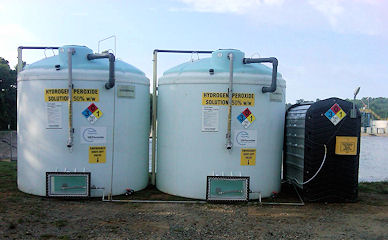Rapid Response: High BOD/COD Levels Require Emergency Supplemental Dissolved Oxygen

On a late Friday
afternoon in June, a call came in to USP Technologies: a major
poultry processing plant in the Southeast was in danger of violating their wastewater
discharge permit. They needed a solution
fast or face fines, a temporary shutdown of operations and significant lost
revenue.
The poultry
plant's 3.5 million gallon aerated wastewater treatment lagoon was unable to
maintain sufficient dissolved oxygen (DO) and was unable to achieve ammonia and
biological oxygen demand (BOD) removal requirements. These conditions were brought about by a
combination of warm seasonal temperatures of over >90 F, (lower O2
solubility) and higher than normal chemical oxygen demand (COD) loading to the treatment
system. In addition, the oxygen depleted
lagoon was generating significant hydrogen sulfide (H2S) odors.
The solution was
a turn-key hydrogen peroxide dosing program to supplement the plant's aeration
equipment and get the lagoon DO levels back to a target range of 2 - 3 mg/L
. (See Supplemental
Dissolved Oxygen for chemistry details on use of H2O2 for supplemental
dissolved oxygen in biological treatment systems)
The USP Technologies'
Engineering team reacted quickly, working over the weekend to prepare an appropriately
designed storage and dosing system and overnight shipping it to the site for
installation in the field. The Team mobilized on Sunday to install and prepare
the systems for a Monday start-up. By
Monday afternoon, the hydrogen peroxide system was fully installed and dosing
started at about 3:00 pm, a mere 72 hours from the initial phone call from the
poultry plant.
Sampling of the
lagoon by USP Technologies demonstrated that, within 24 hours, the hydrogen peroxide
addition to the aerated lagoons resulted in measurable increases in DO and
elimination of H2S odors. With continued
dosing of hydrogen peroxide, the DO levels increased incrementally over the
next several days. By the following weekend, DO levels were back in the 2 - 3
mg/L target range and the ammonia and BOD levels were trending downward. The plant was out of discharge violation
danger. This poultry plant continued to
use hydrogen peroxide for supplemental DO throughout the summer and early fall
until cooler temperatures and lower COD loading to the lagoons allowed their
aeration systems to maintain required DO levels on their own. USP Technologies removed the storage and dosing
systems at the conclusion of the project.
Download our Case Study for Lagoon Supplemental DO (pdf)
Back to top
Get More Information
Contact USP Technologies for more information on our products and services: